Baked French Toast
This post may contain affiliate links. Please read my disclosure policy.
Hi there. With it being the weekend and all, I won’t keep you. I just thought, in case you hadn’t decided on breakfast yet, that you might be interested in this baked French toast, a dish I find nearly impossible not to make at least once a weekend. The recipe comes from Tartine Bread, the book that introduced me to eggplant involtini and kale caesar salad, and like those two, this one’s a good one.
While I love this French toast above all for its texture — caramelized on the outside, not soggy on the inside — what distinguishes it from any other French toast I’ve had, baked or otherwise, is the presence of lemon zest, a most-unexpected and delicious flavor in a traditionally cinnamon-spiked dish.
There are a few keys to finding success with this French toast: 1. Cut the bread into thick slices — way thicker than what will likely feel appropriate. Use a ruler (I did) if you have any question about what an inch-and-a-half looks like. 2. Do not place the skillet in the oven until the bottoms of the bread slices are caramelized — if they’re not caramelized before you place the pan in the oven, they won’t be caramelized when you take them out of the oven. 3. Be sure to bake the slices for a sufficient amount of time. I find 20 to 25 minutes of baking ensures a non-soggy center.
I hope you all have a nice weekend. If you find time to work some baked French toast into one of your mornings — perhaps with a side of bacon — nice, I hope, will be an understatement.
This is what the French toast looks like when it emerges from the oven. The caramelization happens on only one side — the skillet side — and the only flipping involved happens when you’re ready to serve.
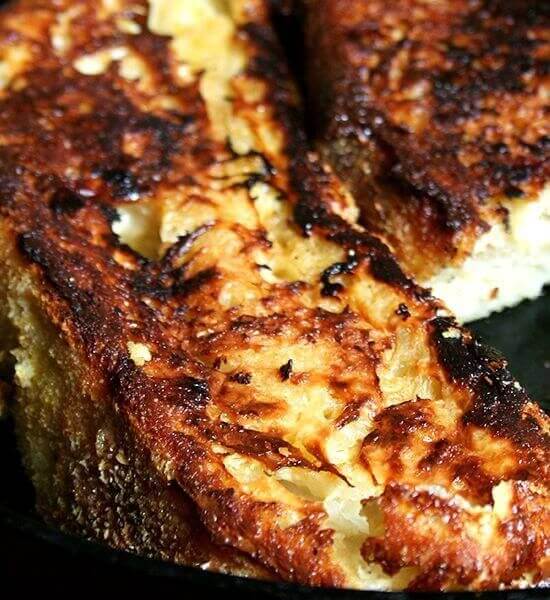
Baked French Toast
- Total Time: 1 hours 35 minutes
- Yield: 2-4 servings
Description
Source: Tartine Bread
Note: The book suggests serving the French toast with maple-glazed bacon and a very ripe Hachiya persimmon. Yum.
Ingredients
- 3 eggs
- 2 tablespoons sugar
- zest of one lemon
- 1/2 teaspoon vanilla extract
- 1/4 teaspoon salt
- 1 cup milk (I used 2%)
- 2 slices day-old country bread*, cut into 1 1/2-inch thick slices
- 2 tablespoons butter
*Any bakery-style loaf will do.
Instructions
- Whisk together the eggs, sugar, lemon zest, vanilla, salt and milk. Place the bread slices in the custard base and let stand until the bread is saturated, about 1 hour.
- Preheat the oven to 350ºF. Place rack in middle of oven.
- Heat an oven-proof skillet (cast-iron skillet works great) over medium-low heat. (Note: really be patient here and keep the heat at medium-low.) Melt the butter to coat the bottom of the pan. Lift each bread slice from the custard base and place in the pan. Cook the slices for about 3 minutes, occasionally pressing them against the bottom of the pan with a spatula so the bottoms cook evenly. This step seals the bottoms of the slices by cooking the outer layer of custard base. It also prepares the bread for receiving more custard base.
- Spoon or ladle more custard base into the center of each bread slice. (Note: I did not do this. The slices seemed saturated enough with custard that adding more seemed unnecessary, but by all means give this a go.) If the liquid leaks out of the bread and onto the skillet, the bread slices are not quite sealed. Continue cooking for 1 minute, pressing the slices slightly to seal. Transfer the skillet to the oven’s middle rack — do not flip over the slices.
- Bake the slices for 12 to 15 minutes. (Note: I find 15 to 20 minutes or even a few minutes more than 20 to be a better length of time — at 12 to 15 minutes, my slices are still soggy in the center. Definitely check the slices at 15 minutes, however. The book notes that it may take up to 20 minutes depending on the thickness of the bread for the slices to cook all the way through.) The French toast is done when the custard seems solid and each slice appears inflated, as the custard souflées when fully cooked.
- Using a spatula, remove the French toast from the skillet and place them, caramelized-side up onto plates. The skillet side should be caramelized and crisp.
- Prep Time: 10 minutes
- Cook Time: 25 minutes
This post may contain affiliate links. Please read my disclosure policy.


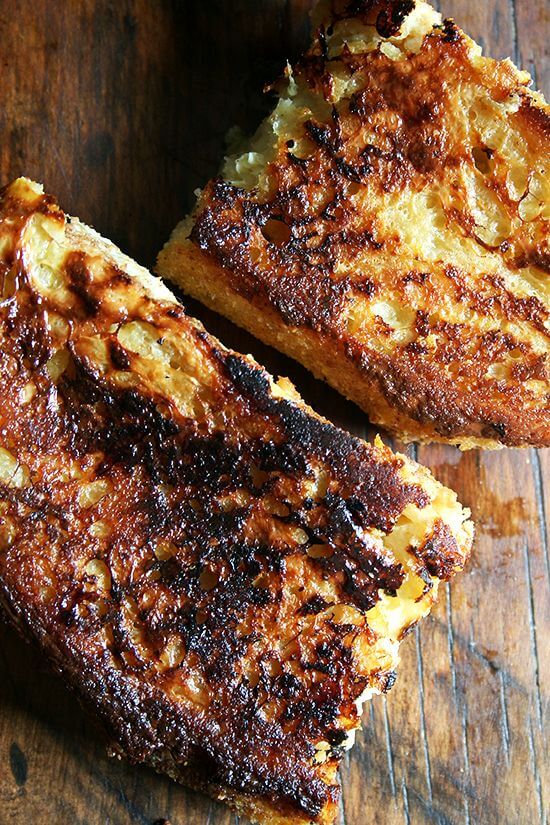
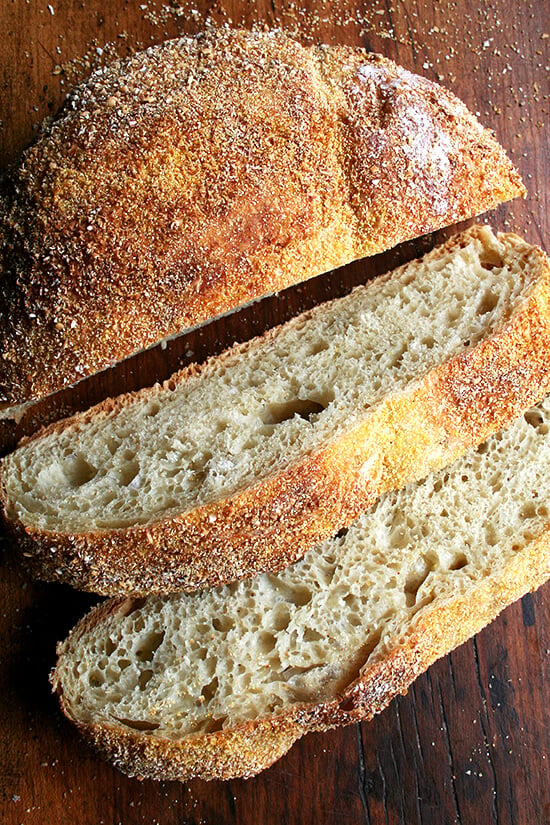

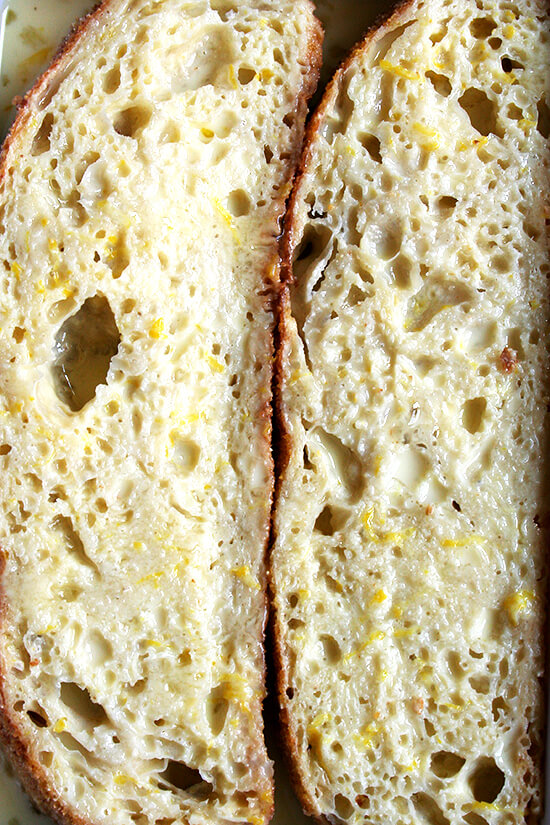
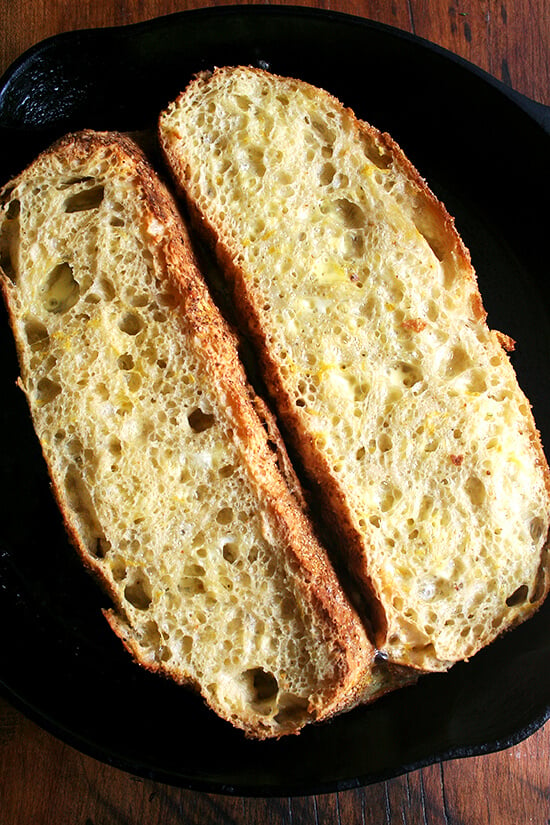
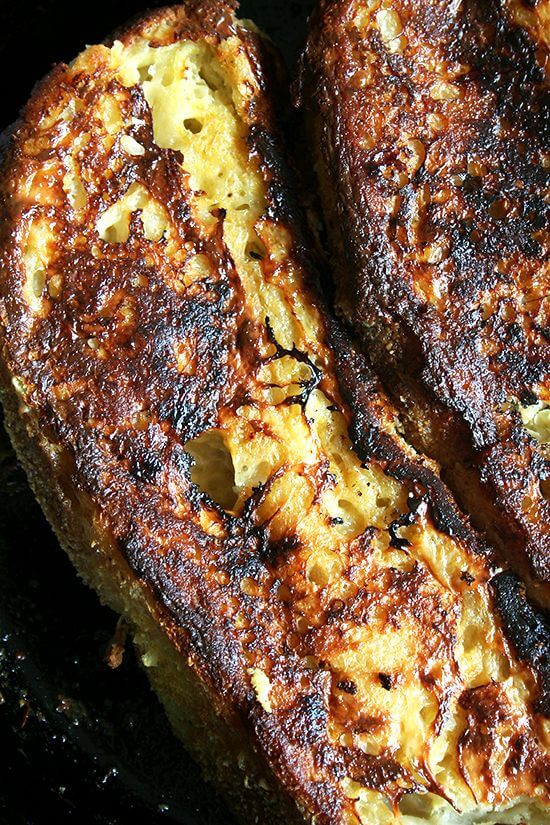










23 Comments on “Baked French Toast”
This looks absolutely stunning! Oh I can’t wait to try it! I’ll have to get myself some deliciously thick bread. Thank you!
Glorious! I am so sorry I don’t have ANY of the ingredients for this!
I only wish I could find such a good bread in London. Great Recipe!
Daniela — you can! You just have to make it yourself. I made a loaf of the Bittman/Leahy No-Knead bread, a recipe I haven’t made in ages, but one that is oh so good. Here is the post I did on it many many years ago: https://alexandracooks.com/2006/11/26/no-knead-bread/
This a great comfort food and I love the bread you used.
Yum, yum. What else can one say!!
Oh how I adore this cookbook. I’ve made a number of things from it, and have always thought it was just so good. French Toast is one of those things that if done right, is so good, and yet so many people do it poorly! I recently did one with blueberries that included orange zest which I imagine provides a similiarly nice touch to the lemon in this one. Yum!
just made it, and we loved it! lemon zest was great in it but next time i’ll see how it is with 1″ thick slices and orange zest.
Nneka — was an 1.5 inches a little too much? Love the idea of orange zest! Also lets chat soon!
Beutiful french toast. I wish I could have one right now with a nice cup of coffee & milk
Oh boy. There are few things in life I love more than a perfect french toast — let alone one that is made from beautiful bread and skillet browned. Que magnifique!
I made this last Friday for breakfast with homemade brioche and orange zest. Next time I may add more of the orange zest – it’s flavor wasn’t quite as strong as I would have liked. Thank you for sharing such a superb recipe!
Hello Alexandra,
Can’t wait to try this now. But I have no orange or lemons for zest. Alas!
Right now I will use something else, as I can’t wait till I buy those fruits . Thanks for this recipe.
Sana — I hope you like it! I love this one. The zest, while perhaps not essential, really does add a lovely touch. Worth waiting to make this recipe until you have some citrus on hand!
What nice french toast. I would never have thought to make it so thick. I can see why it needs to soak in the custard for about an hour, but what a treat if you can wait for that and the baking time. 🙂
This looks like a yummier version of an overnight French toast recipe I lost long ago. Great, I’ll try this one. I do remember that the old recipe suggested added dark rum to the eggy mixture!
Oh that sounds amazing. Yes to the rum!
Love love love this recipe! My husband shook his head up and down with every bite, and gushed about how good it was! The lemon was unexpectedly delicious!
It did take me longer than 3 minutes to caramelize in the skillet on med-low heat. Took me about 10 – 15 minutes. Have you ever made this for 6 people at once? Any tips?
So happy to hear this, Erinn! I know, isn’t the zest nice? I would have never thought to add that to french toast. OK, as for feeding for a crowd, I would suggest browning all of the pieces ahead of time and transferring each piece to a parchment lined baking sheet. Because the pieces will be caramelized before you put them in the oven, they shouldn’t really need a hot pan to finish the baking (does that make sense?) so I think a baking sheet will be just fine. I would line all 6 (or more) pieces of toast up on that baking pan and bake for at least 20 minutes — you might have to bake longer because the sheet pan will be cold when entering the oven. Hope that helps!
Especially sourdough, this is the only bread Tartine makes.
I have no idea why I made that note. I went back to look at the book recipe, and unsurprisingly there is no such note, so I am stumped. Removing note immediately. Thanks.
Had this yumminess this morning. Made 3 slices, so increased to 4 eggs, 1 1/2 cups of milk and added a little almond extract with the vanilla.
I soaked overnight, and took it out of the refrigerator 30 minutes before cooking. Baked 30 minutes. Served with powdered sugar and fruit. Was fantastic!
Wonderful! And so funny: We had this French toast this morning for the first time in ages … must be the change in weather. So glad you liked it!